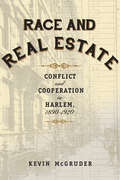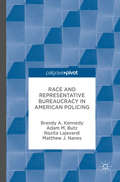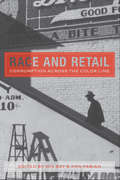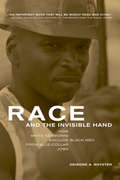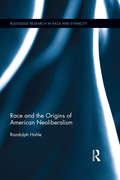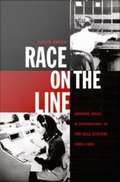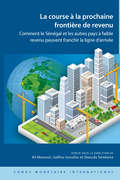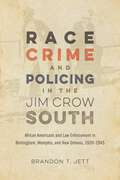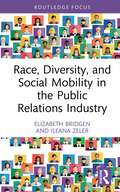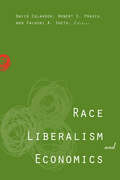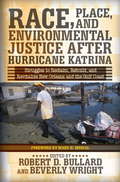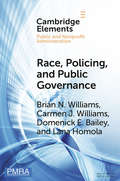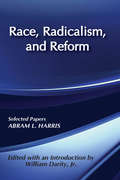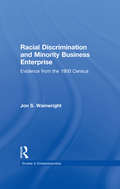- Table View
- List View
Race and Real Estate: Conflict and Cooperation in Harlem, 1890-1920
by Kevin McGruderThrough the lens of real estate transactions from 1890 to 1920, Kevin McGruder offers an innovative perspective on Harlem's history and reveals the complex interactions between whites and African Americans at a critical time of migration and development. During these decades Harlem saw a dramatic increase in its African American population, and although most histories speak only of the white residents who met these newcomers with hostility, this book uncovers a range of reactions. Although some white Harlem residents used racially restrictive real estate practices to inhibit the influx of African Americans into the neighborhood, others believed African Americans had a right to settle in a place they could afford and helped facilitate sales. These years saw Harlem change not into a "ghetto," as many histories portray, but into a community that became a symbol of the possibilities and challenges black populations faced across the nation. This book also introduces alternative reasons behind African Americans' migration to Harlem, showing that they came not to escape poverty but to establish a lasting community. Owning real estate was an essential part of this plan, along with building churches, erecting youth-serving facilities, and gaining power in public office. In providing a fuller, more nuanced history of Harlem, McGruder adds greater depth in understanding its development and identity as both an African American and a biracial community.
Race and Regionalism in the Politics of Taxation in Brazil and South Africa
by Evan S. LiebermanEvan Lieberman's analysis focuses on the politics of taxation as a way of understanding the development of governments. He compares Brazil and South Africa because of their similarities: They are upper-middle-income countries, and highly unequal--both in terms of income and racial status. Lieberman argues that different constitutional approaches to race (whether or not to grant equal citizenship to blacks) and federalism (whether to have it or not) shaped the organization of politics in the two countries, leading to the development of very different tax systems. The findings are based on extensive field research, large-scale national surveys, macroeconomic data, and various archival and secondary sources.
Race and Representative Bureaucracy in American Policing
by Brandy A. Kennedy Adam M. Butz Nazita Lajevardi Matthew J. NanesThis book examines issues of race and policing through the lens of representative bureaucracy theory. According to representative bureaucracy theory, demographic correspondence between government employees and the local population can lead to more favorable outcomes for minority groups. It argues that police forces with higher minority composition will have more positive outcomes across measures such as fewer excessive force complaints and fewer fatal encounters with officers. Additionally, the book asserts that more representative forces will demonstrate responsiveness and accountability by implementing policies such as citizen review boards for excessive force complaints. It does this by first providing a brief overview of issues surrounding race and policing in America, documenting racial representation occurring in local police forces nationwide, and exploring the potential causes and consequences of underrepresentation. It concludes by discussing the implications of our findings and offer potential policy remedies and solutions that local law enforcements can pursue in order to reduce minority underrepresentation and improve policing outcomes.
Race and Retail: Consumption across the Color Line
by Jerome D. Williams Geraldo L. Cadava Ellen D. Wu John W. Heaton Azure B. Thompson Stacey A. Sutton Johana Londoño Anne-Marie G. Hakstian Erualdo R. González Geraldine Rosa Henderson Siobhan Carter-David Professor Ann Fabian Sharese N. Porter Traci Parker Bridget Kenny Neiset Bayouth Melissa L. Cooper Naa Oyo Kwate Sophia R. Evett Professor Mia BayRace has long shaped shopping experiences for many Americans. Retail exchanges and establishments have made headlines as flashpoints for conflict not only between blacks and whites, but also between whites, Mexicans, Asian Americans, and a wide variety of other ethnic groups, who have at times found themselves unwelcome at white-owned businesses. Race and Retail documents the extent to which retail establishments, both past and present, have often catered to specific ethnic and racial groups. Using an interdisciplinary approach, the original essays collected here explore selling and buying practices of nonwhite populations around the world and the barriers that shape these habits, such as racial discrimination, food deserts, and gentrification. The contributors highlight more contemporary issues by raising questions about how race informs business owners' ideas about consumer demand, resulting in substandard quality and higher prices for minorities than in predominantly white neighborhoods. In a wide-ranging exploration of the subject, they also address revitalization and gentrification in South Korean and Latino neighborhoods in California, Arab and Turkish coffeehouses and hookah lounges in South Paterson, New Jersey, and tourist capoeira consumption in Brazil. Race and Retail illuminates the complex play of forces at work in racialized retail markets and the everyday impact of those forces on minority consumers. The essays demonstrate how past practice remains in force in subtle and not-so-subtle ways.
Race and the Invisible Hand
by Stephen Steinberg Deirdre A. RoysterFrom the time of Booker T. Washington to today, and William Julius Wilson, the advice dispensed to young black men has invariably been, "Get a trade." Deirdre Royster has put this folk wisdom to an empirical test--and, in Race and the Invisible Hand, exposes the subtleties and discrepancies of a workplace that favors the white job-seeker over the black. At the heart of this study is the question: Is there something about young black men that makes them less desirable as workers than their white peers? And if not, then why do black men trail white men in earnings and employment rates? Royster seeks an answer in the experiences of 25 black and 25 white men who graduated from the same vocational school and sought jobs in the same blue-collar labor market in the early 1990s. After seriously examining the educational performances, work ethics, and values of the black men for unique deficiencies, her study reveals the greatest difference between young black and white men--access to the kinds of contacts that really help in the job search and entry process.
Race and the Origins of American Neoliberalism (Routledge Research in Race and Ethnicity #12)
by Randolph HohleWhy did the United States forsake its support for public works projects, public schools, public spaces, and high corporate taxes for the neoliberal project that uses the state to benefit businesses at the expense of citizens? The short answer to this question is race. This book argues that the white response to the black civil rights movement in the 1950s, '60s, and early '70s inadvertently created the conditions for emergence of American neoliberalism. Neoliberalism is the result of an unlikely alliance of an elite liberal business class and local segregationists that sought to preserve white privilege in the civil rights era. The white response drew from a language of neoliberalism, as they turned inward to redefine what it meant to be a good white citizen. The language of neoliberalism depoliticized class tensions by getting whites to identify as white first, and as part of a social class second. This book explores the four pillars of neoliberal policy, austerity, privatization, deregulation, and tax cuts, and explains how race created the pretext for the activation of neoliberal policy. Neoliberalism is not about free markets. It is about controlling the state to protect elite white economic privileges.
Race in the Marketplace: Crossing Critical Boundaries
by Guillaume D. Johnson Kevin D. Thomas Anthony Kwame Harrison Sonya A. GrierThis volume offers a critical, cross-disciplinary, and international overview of emerging scholarship addressing the dynamic relationship between race and markets. Chapters are engaging and accessible, with timely and thought-provoking insights that different audiences can engage with and learn from. Each chapter provides a unique journey into a specific marketplace setting and its sociopolitical particularities including, among others, corner stores in the United States, whitening cream in Nigeria and India, video blogs in Great Britain, and hospitals in France. By providing a cohesive collection of cutting-edge work, Race in the Marketplace contributes to the creation of a robust stream of research that directly informs critical scholarship, business practices, activism, and public policy in promoting racial equity.
Race on the Line: Gender, Race, & Technology in the Bell System, 1880-1980
by Venus GreenRace on the Line is the first book to address the convergence of race, gender, and technology in the telephone industry. Venus Green--a former Bell System employee and current labor historian--presents a hundred year history of telephone operators and their work processes, from the invention of the telephone in 1876 to the period immediately before the break-up of the American Telephone and Telegraph Company in 1984. Green shows how, as technology changed from a manual process to a computerized one, sexual and racial stereotypes enabled management to manipulate both the workers and the workplace. More than a simple story of the impact of technology, Race on the Line combines oral history, personal experience, and archival research to weave a complicated history of how skill is constructed and how its meanings change within a rapidly expanding industry. Green discusses how women faced an environment where male union leaders displayed economic as well as gender biases and where racism served as a persistent system of division. Separated into chronological sections, the study moves from the early years when the Bell company gave both male and female workers opportunities to advance; to the era of the "white lady" image of the company, when African American women were excluded from the industry and feminist working-class consciousness among white women was consequently inhibited; to the computer era, a time when black women had waged a successful struggle to integrate the telephone operating system but faced technological displacement and unrewarding work. An important study of working-class American women during the twentieth century, this book will appeal to a wide audience, particularly students and scholars with interest in women's history, labor history, African American history, the history of technology, and business history.
Race to the Next Income Frontier: How Senegal And Other Low-income Countries Can Reach The Finish Line
by International Monetary FundA report from the International Monetary Fund.
Race, Crime, and Policing in the Jim Crow South: African Americans and Law Enforcement in Birmingham, Memphis, and New Orleans, 1920–1945 (Making the Modern South)
by Brandon T. JettThroughout the Jim Crow era, southern police departments played a vital role in the maintenance of white supremacy. Police targeted African Americans through an array of actions, including violent interactions, unjust arrests, and the enforcement of segregation laws and customs. Scholars have devoted much attention to law enforcement’s use of aggression and brutality as a means of maintaining African American subordination. While these interpretations are vital to the broader understanding of police and minority relations, Black citizens have often come off as powerless in their encounters with law enforcement. Brandon T. Jett’s Race, Crime, and Policing in the Jim Crow South, by contrast, reveals previously unrecognized efforts by African Americans to use, manage, and exploit policing. In the process, Jett exposes a much more complex relationship, suggesting that while violence or the threat of violence shaped police and minority relations, it did not define all interactions. Black residents of southern cities repeatedly complained about violent policing strategies and law enforcement’s seeming lack of interest in crimes committed against African Americans. These criticisms notwithstanding, Blacks also voiced a desire for the police to become more involved in their communities to reduce the seemingly intractable problem of crime, much of which resulted from racial discrimination and other structural factors related to Jim Crow. Although the actions of the police were problematic, African Americans nonetheless believed that law enforcement could play a role in reducing crime in their communities. During the first half of the twentieth century, Black citizens repeatedly demanded better policing and engaged in behaviors designed to extract services from law enforcement officers in Black neighborhoods as part of a broader strategy to make their communities safer. By examining the myriad ways in which African Americans influenced the police to serve the interests of the Black community, Jett adds a new layer to our understanding of race relations in the urban South in the Jim Crow era and contributes to current debates around the relationship between the police and minorities in the United States.
Race, Diversity, and Social Mobility in the Public Relations Industry (Global PR Insights)
by Elizabeth Bridgen Ileana ZelerThis book explores the recent academic and practice‑based research and thinking on race, diversity, and social mobility within the public relations industry, arguing for the necessity of more transformative actions to address systemic inequities.Through an analysis of interviews with UK‑based public relations practitioners from a wide range of backgrounds, this book integrates and illustrates different strands of research to shed light on persistent challenges and opportunities in the field and understand how those who are often the subjects of such discussions experience discrimination. The authors introduce complex topics in an accessible manner, providing an overview of recent research, demonstrating practical applications of theoretical frameworks, and suggesting reading for further exploration. It also includes additional pedagogical features which allow readers to explore specific topics through guided reading and exploratory questions.By grounding its analysis in the lived experiences of public relations practitioners, this book contributes to the literature of race, diversity, and social mobility while fostering discussion on the systematic discrimination faced by practitioners. It will help and encourage researchers, educators, and practitioners to critically explore their own practice and open up new conversations about this crucial issue.
Race, Gender, and Leadership in Nonprofit Organizations
by Marybeth Gasman Noah D. Drezner Edward Epstein Tyrone Freeman Vida L. AveryThis volume centers on the lives and experiences of female and African American leaders of foundations and nonprofits. Contributors to the volume examine race and gender as constructs and provide a theoretical background for understanding their effect on the psycho-social development of the individuals.
Race, Gender, and Leadership: Re-Envisioning Organizational Leadership From the Perspectives of African American Women Executives
by Patricia S. ParkerMuch has been written about a model of leadership that emphasizes women's values and experiences, that is in some ways distinct from male models of leadership. This book redirects the focus to a view of leadership as a multicultural phenomenon that moves beyond dualistic notions of "masculine" and "feminine" leadership, and focuses more specifically on leadership as the management of meaning, including the meanings of the notion of "organizational leader. " This volume focuses on leadership "traditions" revealed in the history of Black women in America and exemplified in the leadership approaches of 15 African American women executives who came of age during the civil rights and feminist movements of the 1960's and 1970's and climbed to the top of major U. S. organizations. It advances a vision of organizational leadership that challenges traditional masculine and feminine notions of leadership development and practice, providing insights on organizational leadership in the era of post-industrialization and globalization. Additionally, by placing African American women at the center of analysis, this book provides insights into the ways in which race and gender structure key leadership processes in today's diverse and changing workplace. It is a must-read for scholars and researchers in organizational communication, management, leadership, African American studies, and related areas.
Race, Justice, and the Jury System in Postbellum Virginia
by David A. Moss Dean GrodzinsIn December 1877, an all-white grand jury in Patrick County, Virginia, indicted two black teenagers, Lee and Burwell Reynolds, for killing a white man. After a series of trials, an all-white trial jury convicted Lee of second-degree murder and sentenced him to prison. A separate all-white jury could not reach a verdict on Burwell, and he was returned to jail to await another trial. During the proceedings, the defendants' attorneys had protested to the county judge that their clients could not get fair trials from all-white juries. They also complained that although black men were allowed on juries by Virginia law, no blacks were even in the jury pools. The lawyers asked that special jury pools be created for their clients, but the judge denied their request. Finally, the lawyers petitioned a federal judge in the area, Alexander Rives, to move the trials to his court. In December 1878, Judge Rives agreed to the petition and had the Reynolds brothers removed from state to federal custody. Not long afterward, he charged two federal grand juries, both interracial, to investigate whether Virginia state courts had excluded blacks from juries. This, he argued, would be a violation of both the 14th Amendment to the Constitution (1868) and the federal Civil Rights Act of 1875. In February and March 1879, the grand juries indicted 14 Virginia county judges, among them the judge in the Reynolds trials, for keeping the jury pools they supervised all white.
Race, Liberalism, and Economics
by Robert E. Prasch Falguni A. Sheth David C. ColanderNoneconomists often think that economists' approach to race is almost exclusively one of laissez-faire. Racism, Liberalism, and Economics argues that economists' ideas are more complicated. The book considers economists' support of markets in relation to the challenge of race and race relations and argues that their support of laissez-faire has traditionally been based upon a broader philosophical foundation of liberalism and history: what markets have and have not achieved in the past, and how that past relates to the future. The book discusses the concepts of liberalism and racism, the history and use of these terms, and how that history relates to policy issues. It argues that liberalism is consistent with a wide variety of policies and that the broader philosophical issues are central in choosing policies. The contributors show how the evolution of racist ideas has been a subtle process that is woven into larger movements in the development of scientific thought; economic thinking is embedded in a larger social milieu. Previous discussions of policies toward race have been constrained by that social milieu, and, since World War II, have largely focused on ending legislated and state-sanctioned discrimination. In the past decade, the broader policy debate has moved on to questions about the existence and relative importance of intangible sources of inequality, including market structure, information asymmetries, cumulative processes, and cultural and/or social capital. This book is a product of, and a contribution to, this modern discussion. It is uniquely transdisciplinary, with contributions by and discussions among economists, philosophers, anthropologists, and literature scholars. The volume first examines the early history of work on race by economists and social scientists more generally. It continues by surveying American economists on race and featuring contributions that embody more modern approaches to race within economics. Finally it explores several important policy issues that follow from the discussion. ". . . adds new insights that contribute significantly to the debate on racial economic inequality in the U. S. The differing opinions of the contributors provide the broad perspective needed to examine this extremely complex issue. " --James Peoples, University of Wisconsin-Milwaukee "There is an immense economic literature on racial discrimination, employing a variety of models and decomposition methods. This volume makes a unique contribution by focusing on the philosophical assumptions at the root of this analysis and by presenting many sides of the very vigorous debate surrounding these controversial issues. " --Thomas Maloney, University of Utah "By focusing upon the progress of analytical technique, historians of economic thought have grossly neglected the symbiotic relation of economics to public policy and ideology. This collection of essays offers a most welcome breach of disciplinary apartheid. Seizing upon recent research in the almost forgotten writings about race of Classical economists and their contemporaries, it relates nineteenth-century ideas to current debates about economic discrimination and other manifestations of racism. As the writing is both learned and lively, the book should appeal both to the generally educated reader and to teachers of courses in multiculturalism. " --Melvin Reder, Isidore Brown and Gladys J. Brown Professor Emeritus of Urban and Labor Economics, University of Chicago
Race, Place, and Environmental Justice After Hurricane Katrina
by Robert BullardAnalyzing the immediate and long-term repercussions of Hurricane Katrina, the essays in this volume expose the racial disparities that exist in disaster response and recovery and challenge the geography of vulnerability
Race, Policing, and Public Governance: On the Other Side of Now (Elements in Public and Nonprofit Administration)
by Brian N. Williams Carmen J. Williams Domenick E. Bailey Lana HomolaI can't breathe … a haunting phrase moaned at the intersection of past and present, serving as an audible supplement to the visual evidence to yet another collision of race and policing. This phrase reflects the current state of police-community relations in the United States. But, what lies on the other side of now? This Element examines this salient question in the context of excessive use of force and through the lenses of race, policing and public governance. We draw upon extant research and scholarship on representative bureaucracy, public engagement in the co-creation of public polices and the co-production of public services, and the emerging findings from studies in network science, coupled with insights from elite interviews, to offer implications for future research, the profession of policing, the public policymaking process, public management, and post-secondary institutions.
Rachael Ray: Cooking Up a Brand
by Boris Groysberg Kerry HermanThe case details the rapid rise of Rachael Ray's career, beginning with her first appearance on NBC's Today show in March 2001. The case chronicles her success, exploring her various brands, promotional work and expansion into new media markets. The case also allows students to grapple with the challenges Rachael Ray might face in terms of the continued sustainability of her successful brand.
Rachael Ray: Cooking Up a Brand
by Boris Groysberg Kerry HermanThe case details the rapid rise of Rachael Ray's career, beginning with her first appearance on NBC's Today show in March 2001. The case chronicles her success, exploring her various brands, promotional work and expansion into new media markets. The case also allows students to grapple with the challenges Rachael Ray might face in terms of the continued sustainability of her successful brand.
Rachael Ray: From Candy Counter to Cooking Show (Extraordinary Success with a High School)
by Shaina C. IndovinoIn the last few decades, more and more people are going to college to further their education. It's hard to become a scientist, a professor, or a businessperson without getting some sort of college degree--but college isn't always necessary to achieve success. Some people are ready to enter the workforce right after high school. Rachael Ray was one of those people. The cooking television and talk show star began her career working in restaurants and, for a little while, at the candy counter at Macy's in New York City. After becoming the chef at a prestigious hotel restaurant, Rachael worked her way from sous-chef to superstar! Today, shows like "30 Minute Meals", "Rachael Ray's Tasty Travels", and, of course, "Rachael Ray", have made Rachael one of the most successful people in television. And what's most amazing about Rachael's story is that she's done it all without a college degree!
Racial Discrimination and Minority Business Enterprise: Evidence from the 1990 Census (Garland Studies in Entrepreneurship)
by Jon S. WainwrightFirst Published in 2000. Routledge is an imprint of Taylor & Francis, an informa company.
Racial Discrimination on Airbnb
by Michael Luca Hyunjin Kim Scott Stern Devin CookFacing mounting criticism and evidence of widespread racial discrimination on the platform, apartment rental platform Airbnb needed to decide a path forward. For years, Airbnb had given hosts extensive discretion about whether to reject a guest after seeing little more than a name and a picture, believing this was the best way for the company to build trust. While Airbnb ran thousands of experiments per year looking at ways to grow the user base and short-run profit, they failed to track or account for the possibility of discrimination. Should they become more proactive about identifying discrimination on the platform? Should they change the design of the platform to reduce discrimination? If so, how would they decide whether the changes were successful?

